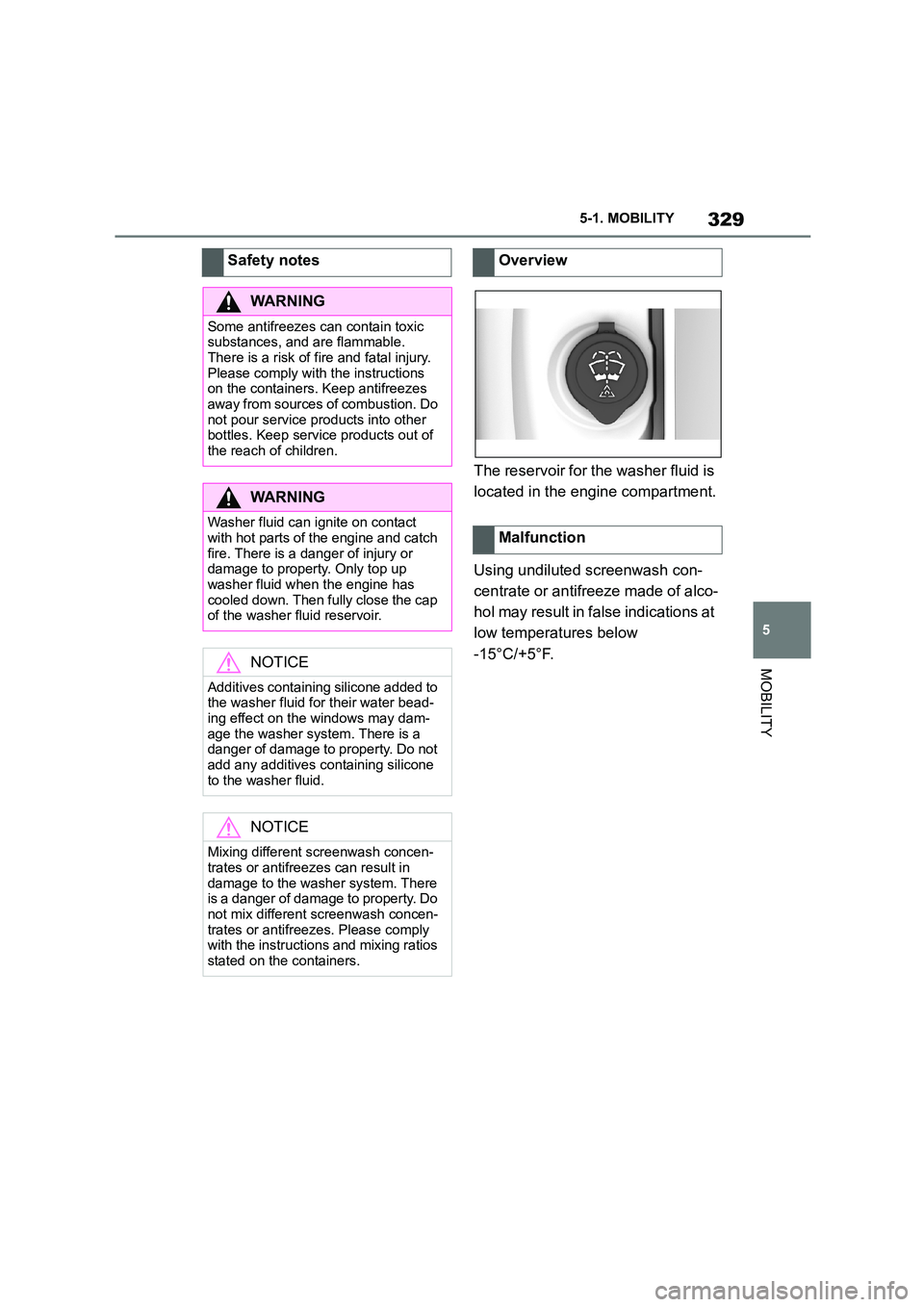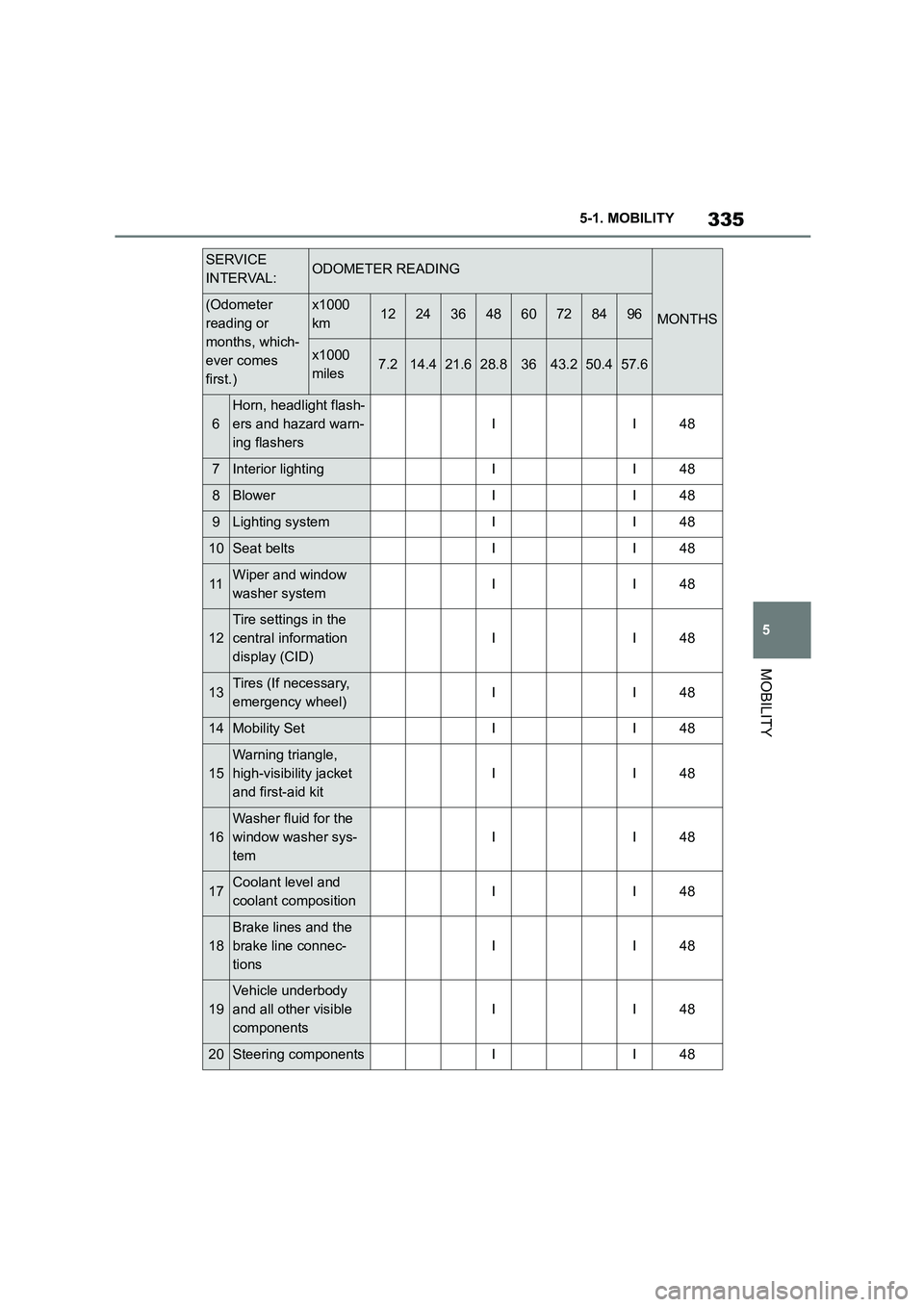2022 TOYOTA SUPRA washer fluid
[x] Cancel search: washer fluidPage 155 of 498

153
3
3-1. CONTROLS
CONTROLS
Turn the knurled wheel to set the
sensitivity of t he rain sensor.
Upwards: high sensitivity of the rain
sensor.
Downwards: low se nsitivity of the
rain sensor.
Pull the lever.
Fluid from the washer fluid reser-
voir is sprayed on to the windscreen
and the wipers are operated briefly.
The windscreen washer jets are
automatically heated when standby
state is switched on.
The wipers can be folded out from
the windscreen in the fold-out posi-
tion. This is necessary for example
when replacing the wiper blades or
to keep them away from the wind-
screen when there is frost.
Setting the sensitivity of the rain
sensor
Windscreen washer
Safety notes
WA R N I N G
At low temperatures, the washer fluid can freeze onto the windscreen and
restrict visibility. There is a danger of
accidents. Only use the washer sys- tems if there is no possibility of the
washer fluid freezing. Use antifreeze
if required.
NOTICE
If the washer fluid reservoir is empty,
the washer pump cannot operate as
intended. There is a danger of dam- age to property. Do not use the
washer system with the washer fluid
reservoir empty.
Cleaning the windscreen
Windscreen washer jets
Fold-out position of the wip-
ers
Principle
Page 330 of 498

3285-1. MOBILITY
be overfilled in the coolant tank.
The normal level of the coolant
level is achieved by prolonging the
operating time.
The coolant level is indicated by
means of the max. mark in the filler
neck of the coolant expansion tank.
For further information:
Overview, see page 320.
1 Allow the engine to cool down.
2 Open the bonnet, see page 321.
3 Turn cap on coolant tank slightly
anticlockwise, then allow the
pressure to escape.
4 Open cap on coolant tank.
5 The coolant level is correct if it is
just below the Max. mark in the
filler neck.
6 Tighten cap.
1 Allow the engine to cool down.
2 Open the bonnet, see page 321.
3 Turn cap on coolant tank slightly
anticlockwise, then allow the
pressure to escape.
4 Open cap on coolant tank.
5 If necessary, slowly top up to the
correct level; do not overfill.
6 Tighten cap.
7 Have the cause of coolant loss
rectified as soon as possible.
■Disposal
When disposing of coolant and
coolant additives, comply with the
relevant environmental protection
regulations.
All washer jets are supplied from
one tank.
Use a mixture of tap water and
screenwash concentrate for the
windscreen washer system, if nec-
essary with the addition of anti-
freeze.
Recommended minim um fill level: 1
litre, 1.7 Imp. pints.
Checking the coolant level
Topping up
Washer fluid
General
Page 331 of 498

329
5
5-1. MOBILITY
MOBILITY
The reservoir for the washer fluid is
located in the engine compartment.
Using undiluted screenwash con-
centrate or antifreeze made of alco-
hol may result in fa lse indications at
low temperatures below
-15°C/+5°F.
Safety notes
WA R N I N G
Some antifreezes can contain toxic
substances, and are flammable. There is a risk of fire and fatal injury.
Please comply with the instructions
on the containers. Keep antifreezes away from sources of combustion. Do
not pour service products into other
bottles. Keep service products out of
the reach of children.
WA R N I N G
Washer fluid can ignite on contact
with hot parts of the engine and catch fire. There is a danger of injury or
damage to property. Only top up
washer fluid when the engine has cooled down. Then fully close the cap
of the washer fluid reservoir.
NOTICE
Additives containing silicone added to the washer fluid for their water bead-
ing effect on the windows may dam-
age the washer system. There is a danger of damage to property. Do not
add any additives containing silicone
to the washer fluid.
NOTICE
Mixing different screenwash concen-
trates or antifreezes can result in
damage to the washer system. There is a danger of damage to property. Do
not mix different screenwash concen-
trates or antifreezes. Please comply with the instructions and mixing ratios
stated on the containers.
Overview
Malfunction
Page 337 of 498

335
5
5-1. MOBILITY
MOBILITY
6
Horn, headlight flash-
ers and hazard warn-
ing flashers
II48
7Interior lightingII48
8BlowerII48
9Lighting systemII48
10Seat beltsII48
11Wiper and window
washer systemII48
12
Tire settings in the
central information
display (CID)
II48
13Tires (If necessary,
emergency wheel)II48
14Mobility SetII48
15
Warning triangle,
high-visibility jacket
and first-aid kit
II48
16
Washer fluid for the
window washer sys-
tem
II48
17Coolant level and
coolant compositionII48
18
Brake lines and the
brake line connec-
tions
II48
19
Vehicle underbody
and all other visible
components
II48
20Steering componentsII48
SERVICE
INTERVAL:ODOMETER READING
MONTHS(Odometer
reading or
months, which-
ever comes
first.)
x1000
km1224364860728496
x1000
miles7.214.421.628.83643.250.457.6
Page 339 of 498

337
5
5-1. MOBILITY
MOBILITY
4Brake padsReplace when the brake warning light
appears.-
5Brake fluidFirst replace at 36 months, then replace at every 24
months.
6
Horn, headlight flash-
ers and hazard warn-
ing flashers
II36
7Interior lightingII36
8BlowerII36
9Lighting systemII36
10Seat beltsII36
11Wiper and window
washer systemII36
12
Tire settings in the
central information
display (CID)
II36
13Tires (If necessary,
emergency wheel)II36
14Mobility SetII36
15
Warning triangle,
high-visibility jacket
and first-aid kit
II36
16
Washer fluid for the
window washer sys-
tem
II36
17Coolant level and
coolant compositionII36
18Brake lines and the
brake line connectionsII36
SERVICE INTER-
VA L :ODOMETER READING
MONTHS(Odometer read-
ing or months,
whichever comes
first.)
x1000
km20406080100120
x1000
miles122436486072
Page 367 of 498

365
5
5-1. MOBILITY
MOBILITY
Remove dust from the leather at
regular intervals with a cloth or vac-
uum cleaner.
Dust and road dirt will otherwise
become worked into pores and
folds, resulting in considerable
abrasion and causing the leather
surface to become prematurely brit-
tle.
In order to protect against discol-
ouration, for example from clothing,
clean and care for the leather
approximately every two months.
Clean light-coloured leather more
frequently as it has the tendency to
soil faster.
Use leather cleaner, otherwise dirt
and grease will atta ck the protec-
tive coating of the leather.
Clean the synthetic leather regu-
larly with a damp microfibre cloth or
vacuum cleaner.
Dust and road dirt will otherwise
become worked into pores and
folds, resulting in considerable
abrasion and causing the surface to
become prematurely brittle.
In case of major contaminations,
use a moist soft sponge or microfi-
bre cloth with a suitable interior
cleaners.
Remove aggressive substances,
for example sunscreen, immedi-
NOTICE
■To prevent paint deterioration
and corrosion on the body and
components (aluminum wheels etc.)
Observe the following precautions:
●Wash the vehicle immediately in the
following cases:
• After driving near the sea coast
• After driving on salted roads
• If coal tar or tree sap is present on the paint surface
• If dead insects, insect droppings or bird droppings are present on the
paint surface
• After driving in an area contami-
nated with soot, oily smoke, mine
dust, iron powder or chemical sub- stances
• If the vehicle becomes heavily soiled with dust or mud
• If liquids such as benzene and gas- oline are spilled on the paint sur-
face
●If the paint is chipped or scratched,
have it repaired immediately.
●To prevent the wheels from corrod-
ing, remove any dirt and store in a
place with low humidity when stor- ing the wheels.
For the matte paintwork, pay attention to the following as well:
●If anything is spilled on a painted surface, wipe it off as soon as pos-
sible. If spilled washer fluid or alka-
line fluids are left as is, the paint in the affected area may deteriorate,
causing blemishing.
●Do not wax or apply coating to the
vehicle. Doing so may cause a
change in the body surface's tex- ture or irregularities in the paint.
Leather care
Synthetic leather care